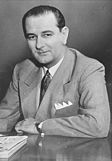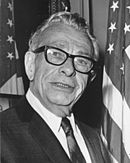United States Senate elections, 1960
|
|
||||||||||||||||||||||||||||||||||
|---|---|---|---|---|---|---|---|---|---|---|---|---|---|---|---|---|---|---|---|---|---|---|---|---|---|---|---|---|---|---|---|---|---|---|
|
||||||||||||||||||||||||||||||||||
|
35 of the 100 seats in the United States Senate 51 seats needed for a majority |
||||||||||||||||||||||||||||||||||
|
||||||||||||||||||||||||||||||||||

Republican hold
Republican gain
Democratic hold
Democratic gain
|
||||||||||||||||||||||||||||||||||
|
||||||||||||||||||||||||||||||||||
The United States Senate elections of 1960 coincided with the election of John F. Kennedy as president. The Republicans gained one seat at the expense of the Democrats. The Democrats nonetheless retained a commanding lead in the Senate with 64 seats to 36. As Majority Leader Lyndon B. Johnson was elected Vice President, Mike Mansfield became the new Majority Leader.
The Republicans' net gain of one seat was eliminated after the election.
The Republicans gained one seat during the next Congress.
...
Wikipedia


